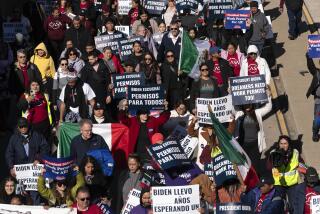San Diego launches bipartisan plan to welcome immigrants
San Diego Mayor Kevin Faulconer, a Republican, will announce on Monday a new position in his office to carry out a five-year plan to make the city more welcoming to immigrants.
In stark contrast to the ongoing stalemate at the federal level over immigration and the border, Faulconer will be joined by San Diego City Council President Georgette Gómez, a Democrat, to unveil the plan — a list of 20 recommendations put together over a year through community input and guidance from civic, business, education and nonprofit leaders.
“Immigrants from around the globe help define our city. San Diego has long been a destination for people in search of opportunity, refugees looking to rebuild their lives, and new citizens who are proud to call America home,” Faulconer said. “San Diego’s economy, workforce and future growth are connected to our ability to welcome new Americans into our community.”
To move the plan forward, Faulconer included $70,000 in his midyear budget report to hire an immigrant affairs manager, whose role will be to coordinate existing efforts to serve immigrant and refugee communities and to triage and implement recommendations in the plan.
“We do it differently here,” said Joel Day, one of the San Diego mayor’s office staff who led the research initiative to make the plan. “At the end of the day, we don’t get to set federal policy on immigration — who comes in and who goes out — but what we do have control over is making people feel welcome in our city. Whether you’re a Democrat or a Republican, it doesn’t matter. We want everybody to feel welcome here.”
The initiative launched at the beginning of last February after the city, in partnership with the San Diego Regional Chamber of Commerce and several nonprofits, received a grant to research ways to better integrate and support immigrant residents.
At the launch, about 300 people shared insights and ideas about where the city should focus its efforts to be more welcoming. Over the next four months, researchers held seven community forums across the city to gather input. They also gathered feedback online through September.
A steering committee of 19 local leaders continued to meet with community members as they drafted the report’s recommendations. Other stakeholders were invited to participate in an online draft, and at one point, Day saw about 40 people editing it at the same time, he said.
“The community engagement was remarkable,” he said.
Sometimes people disagreed, Day said, but disagreement never devolved to divisive argument.
The recommendations included providing more opportunities to immigrant workers and entrepreneurs, increasing civic engagement, removing barriers to education and access to city services and improving relationships between immigrant communities and local police. Each recommendation has short-term and long-term suggestions for how to implement it.
Among those suggestions: additional grants and microloans to help immigrants with foreign credentials use their skills to work in the U.S., a San Diego World Cup soccer tournament of neighborhood-based teams, and an office of immigrant affairs at the city level.
It will be the immigrant affairs manager’s job to sort through those possibilities and work with the community to make them a reality, Day said.
Day said it was important to note that many of the issues brought forward by members of immigrant communities were the same issues that many U.S.-born people worried about, such as housing and transportation.
Part of the point, Day said, is to make sure that conversations about how to handle those issues include immigrants and refugees, as they are often overlooked during policy planning.
Several steering committee members hoped to see the staff position evolve into an office for the city. They said they worried if the position remained in the mayor’s office, it could be scrapped by a future mayor.
“For us this plan will remain just that — a plan — unless we commit the resources to make it happen,” said Karim Bouris, executive director of Business for Good and member of the steering committee.
Paola Avila, vice president of international business affairs at the San Diego Regional Chamber of Commerce and a member of the plan’s steering committee, said recommendations that increased the economic power of immigrants in San Diego would be a big win for the region.
“Based on what we know already, the ROI is going to be tremendous,” Avila said, citing a report produced for the research that found San Diego County immigrants made up about 24% of the population and 33% of its local entrepreneurs.
Andrea Guerrero, executive director of Alliance San Diego and another member of the steering committee, said she was “cautiously optimistic” about the plan getting fully implemented and called the mayor’s decision to create a staff position an important first step.
She also thinks the report’s recommendations to help people from different communities in San Diego get to know each other better will be particularly well-received. She was surprised how many people — immigrant and U.S.-born alike — expressed an interest in more ways to connect.
“That’s part of the immigrant experience is wanting to know your sister and brother, wanting to know your neighbor. But we heard a lot of that also from San Diego-born” residents, Guerrero said. “They want to know who their new neighbors are and know them not in a superficial way but engage in dialogue and relationships. That warmed my heart to see.”
Faulconer was set to reveal the report and new staff position at 10 a.m. Monday at the New Americans Museum in San Diego.
Morrissey writes for the San Diego Union-Tribune.
More to Read
Start your day right
Sign up for Essential California for news, features and recommendations from the L.A. Times and beyond in your inbox six days a week.
You may occasionally receive promotional content from the Los Angeles Times.






